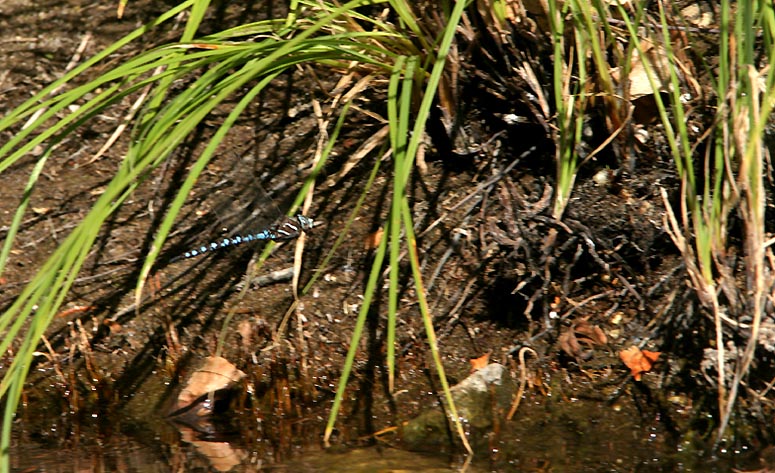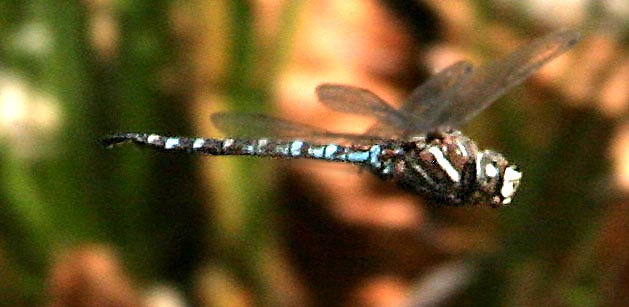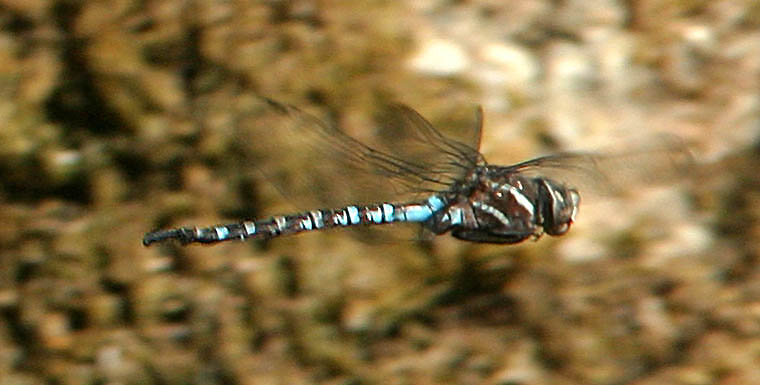| |
|
|
WALKER'S DARNER
Aeshna
walkeri
|

The male Walker's Darner is a restless beast. "Males patrol low over
the water, meticulously checking the inlets and rocky crevasses lining
the margins of pools in the streambed for females that have come to
oviposit
in seams of moss and the submerged roots of plants;" (Manolis 2003).
That
is exactly what this male is doing along the edges of the upper San
Antonio
River. In the photo below, he will go check into every nook and cranny
of the tangled roots you can see, then quickly move on to the next such
patch of vegetation upstream. He does this for several hundred yards,
and
then makes a return trip — time after time, hour after hour. Because he
was predictable, this allowed me to wait for each brief appearance at
try
to snap flight photos. I have yet to see on that wasn't in flight. I've
only seen one female so far, and she, too, was in flight (and not
photographed).

photo (above and
below) 23 Sep 2006
North Fork San Antonio River ©
D. Roberson
|

| Identification criteria include (a) a white
face with only a faint
brownish stripe across it; (b) dark brown eyes; (c) very little yellow
or green color on the thoracic stripes, which are instead usually quite
white; and (d) broad paddle-shaped cerci on males. Our common Blue-eyed
Darner has a blue face and blue eyes and different cerci. Paddle-tailed
Darner has a black stripe across a yellow-green face and yellow stripes
on the thorax. Although extremely difficult to see in the field,
Walker's
also has a very short spine at the low tip of the cerci while the spine
on Paddle-tailed is a bit longer and extends beyond the end of the
'paddle.'
[I.d. points from Manolis 2003]. Also, Paddle-tailed Darner has a large
blue spot atop the final (10th) abdominal segment that is lacking (or
very
reduced) in Walker's Darner. |

|
| Walker's Darner also has a black pterostigma. You
can see this is a
few of these flight shots. This is (again) something that is hard to
see
in the field. Male Paddle-tailed Darner can also have a black
pterostigma
but all other species have a brown one (Manolis 2003). Shadow Darner A.
umbrosa has not yet been recorded in MTY but it is similar to
Walker's in overall pattern (white white, brown eyes, no blue spot on
10th
segment) and in behavior. However, it shows some yellow or green on the
thoracic stripes and has a brown pterostigma.
photo (above) 23
Sep 2006 © D. Roberson
Nacimiento River below Ponderosa Camp
|
| Walker's Darner was first collected in MTY on 17
July 1943 along Finch
Creek, adjacent to Hastings Natural History Reservation. The specimen,
then housed as Hastings, was identified as 'Aeshna palmata'
[Paddle-tailed
Darner]. The record was not published but was eventually posted to
Hastings'
web site. The entire HNHR collection was eventually moved to the
Oakland
Museum, and this specimen was reviewed in August 2006 by Tim Manolis.
The
specimen, a male, has a very short spine on the lower tip of its cerci.
Manolis correctly the identification to A. walkeri. This
constituted
a first county record. All other on the status and distribution of this
species was obtained after than date, and primarily during work by D.
Roberson
in the Santa Lucias in Sep-Oct 2006.
Walker's Darner prefers shady streams and rivers
with appropriate riverside
root-balls and vegetation. These are (so far) all in mountainous
country
in MTY. It has not been found on more sluggish rivers running through
the
lowlands.
 So
far Walker's Darner is known from MTY only from rivers and creeks
running
down the eastern slope of the Santa Lucia Mountains. It occurs
along
the upper Carmel, San Antonio, and Nacimiento rivers, and various other
creeks (e.g., Piney Creek, Finch Creek) that flow into these rivers or
the Arroyo Seco. However, it occurs regularly in the mountains of San
Benito
County to the east, so might be expected along more permanent streams
in
the Diablo Range. So
far Walker's Darner is known from MTY only from rivers and creeks
running
down the eastern slope of the Santa Lucia Mountains. It occurs
along
the upper Carmel, San Antonio, and Nacimiento rivers, and various other
creeks (e.g., Piney Creek, Finch Creek) that flow into these rivers or
the Arroyo Seco. However, it occurs regularly in the mountains of San
Benito
County to the east, so might be expected along more permanent streams
in
the Diablo Range.
Walker's Darner is a late flyer. Dates range
from 17 July to 7 October.
These are similar to dates elsewhere in California, although some
southern
individuals fly into November.
|
|
|
Literature cited:
- Manolis, T. 2003. Dragonflies and Damselflies of
California. Univ. of
Calif.
Press, Berkeley.
Web resources:
Major identification web sites with much information on California
odes include:
For sites with excellent photos to compare for identification or to
simply
enjoy, see:
Many of these sites have links to other useful pages. Kathy Biggs's
site
is particularly useful in her selection of links. |
|
All photos © Don Roberson 2007
TOP
|
|
|
|
|
|
|
|
|
